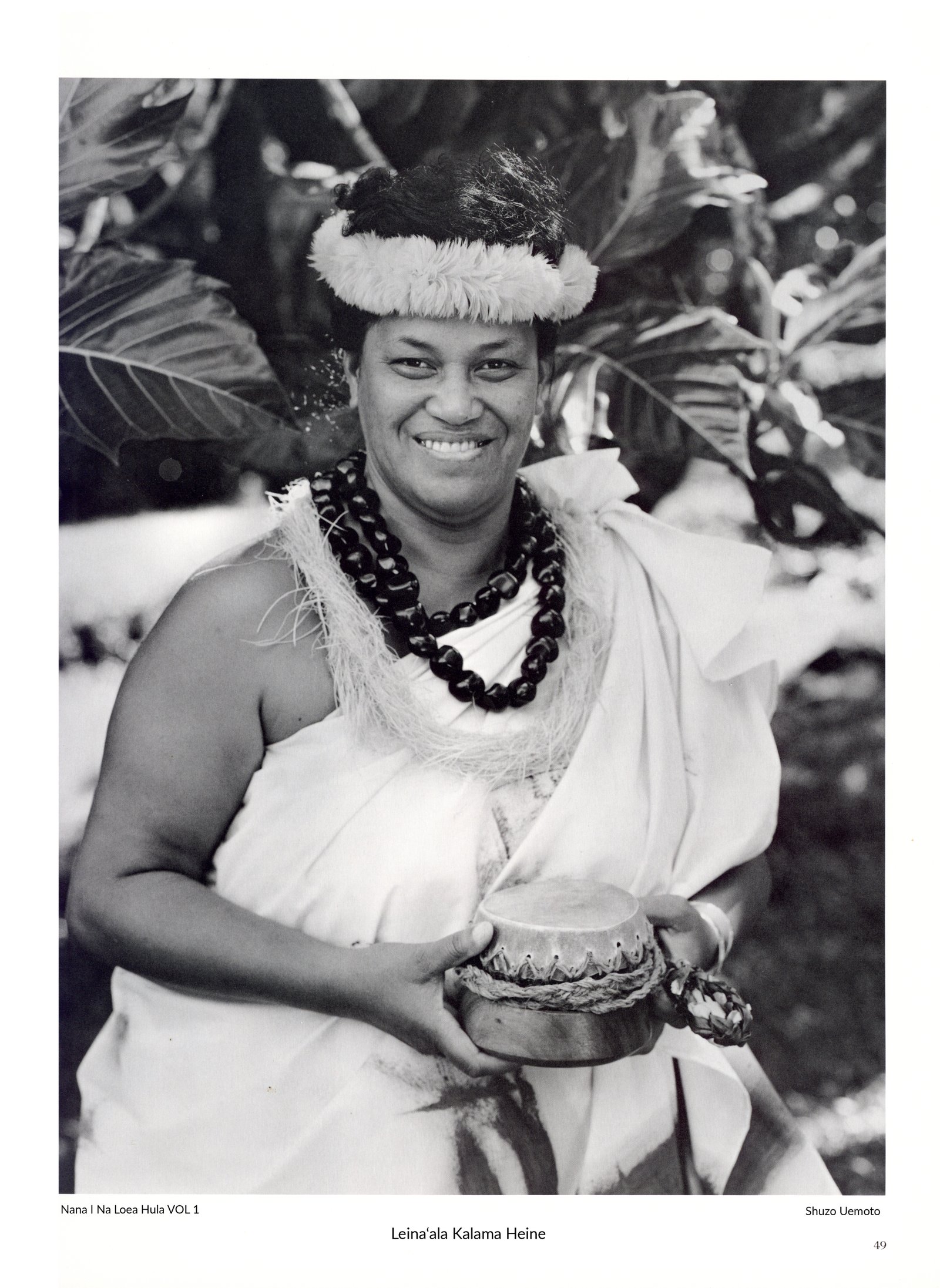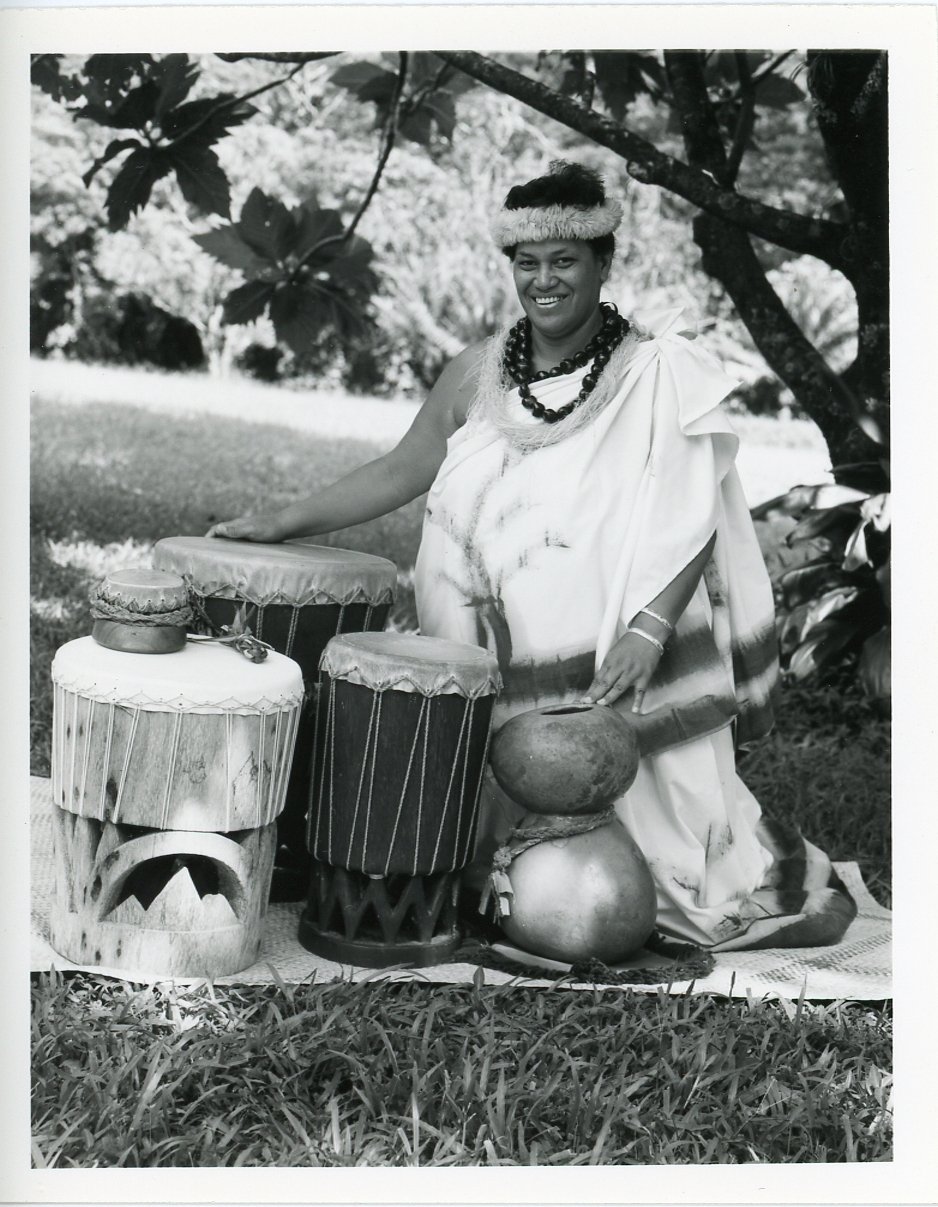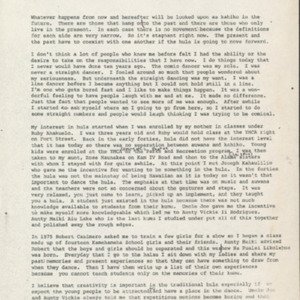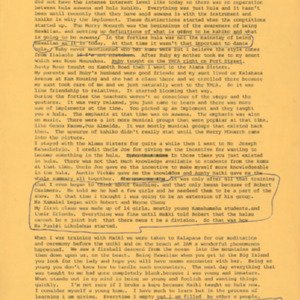Leina‘ala Kalama Heine
Title
Leina‘ala Kalama Heine
Description
Leinaʻala Kalama Heine
Leināʻala Kalama Heine, born and raised in Pālama, O‘ahu, opened her hālau Na Pualei O Likolehua in 1975. She is a featured dancer with the musical group The Brothers Cazimero.
Whatever happens from now and hereafter will be looked upon as kahiko in the future. There are those that hang on to the past and there are those who only live in the present. In each case there is no movement because the definitions for each side are very narrow. So it’s stagnant right now. The present and the past have to co-exist with one another if the hula is going to move forward.
I don’t think a lot of people who knew me before felt I had the ability or the desire to take on the responsibilities that I have now. I do things today that I never would have done ten years ago. The comic dancer was my role. I was never a straight dancer. I fooled around so much that people wondered about my seriousness. But underneath, the straight dancing was my want. I was a line dancer before I became anything but I could not hold still in a line. I’m one who gets bored fast and I like to make things happen. It was a wonderful feeling to have people laugh with me and at me. It made no difference. Just the fact that people wanted to see more of me was enough. After awhile I started to ask myself where am I going to go from here, so I started to do some straight numbers and people would laugh thinking I was trying to be comical.
My interest in hula started when I was enrolled by my mother in classes under Ruby Ahakuelo. I was three years old and Ruby would hold class at the YMCA (Young Men’s Christian Association) right on Fort Street. Back in the early Forties, hula did not have the interest level that it has today so there was no separation between ‘auwana and kahiko. Young kids were enrolled at the YMCA or the Department of Parks and Recreation program. I was then taken to my aunt, Rose Maunakea on Kam IV Road and then to the Alama Sisters (Pua and Lei) with whom I stayed with for quite awhile. At this point I met Joseph Kahaulilio who gave me the incentive for wanting to be something in the hula. In the Forties the hula was not the mainstay of being Hawaiian as it is today so it wasn’t that important to dance the hula. The emphasis at that time was on music and ‘auwana and the teachers were not so concerned about the gestures and steps. It was very relaxed, you just came to learn, picked up an implement, and they taught you a hula. A student just existed in the hula because there was not much knowledge available to students from their kumu. Uncle Joe gave me the incentive to make myself more knowledgeable which led me to Aunty Vickie I‘i Rodrigues. Aunty Mā‘iki Aiu Lake, who is the last kumu I studied under, put all of this together and polished away the rough edges.
In 1975 Robert Cazimero asked me to train a few girls for a show, so I began a class made up of fourteen Kamehameha School girls and their friends. Aunty Ma‘iki advised Robert that the boys and girls should be separated and this was how Na Pualei O Likolehua was born. Everyday that I go to the halau, I sit down with my ladies and share my past memories and present experiences so that they can have something to draw from when they dance. Then I have them write up a list of their own experiences because you cannot teach students only on the memories of their kumu.
I believe that creativity is important in the traditional hula especially if we expect the young people to be attracted to and have a place in the dance. Uncle Joe and Aunty Vickie always told me that repetitious motions become boring and that no two dances or movements should be alike. When you write a new mele you are writing from the viewpoint of your lifetime; when you lived, when you trained, when you taught. Your boundary is your death and that life span will record and preserve and express your existence. That is exactly what our masters and ancestors did before us and hopefully that’s what will happen with the generations after us. The meles that we write today are going to be the kahiko of the following generations but there has to be limits to creativity as well. Our ancestors have set guidelines for the traditional hula but not everyone follows them. So what we have to work towards is a kahiko that is traditional but also accessible to people who are new to it.
Leināʻala Kalama Heine, born and raised in Pālama, O‘ahu, opened her hālau Na Pualei O Likolehua in 1975. She is a featured dancer with the musical group The Brothers Cazimero.
Whatever happens from now and hereafter will be looked upon as kahiko in the future. There are those that hang on to the past and there are those who only live in the present. In each case there is no movement because the definitions for each side are very narrow. So it’s stagnant right now. The present and the past have to co-exist with one another if the hula is going to move forward.
I don’t think a lot of people who knew me before felt I had the ability or the desire to take on the responsibilities that I have now. I do things today that I never would have done ten years ago. The comic dancer was my role. I was never a straight dancer. I fooled around so much that people wondered about my seriousness. But underneath, the straight dancing was my want. I was a line dancer before I became anything but I could not hold still in a line. I’m one who gets bored fast and I like to make things happen. It was a wonderful feeling to have people laugh with me and at me. It made no difference. Just the fact that people wanted to see more of me was enough. After awhile I started to ask myself where am I going to go from here, so I started to do some straight numbers and people would laugh thinking I was trying to be comical.
My interest in hula started when I was enrolled by my mother in classes under Ruby Ahakuelo. I was three years old and Ruby would hold class at the YMCA (Young Men’s Christian Association) right on Fort Street. Back in the early Forties, hula did not have the interest level that it has today so there was no separation between ‘auwana and kahiko. Young kids were enrolled at the YMCA or the Department of Parks and Recreation program. I was then taken to my aunt, Rose Maunakea on Kam IV Road and then to the Alama Sisters (Pua and Lei) with whom I stayed with for quite awhile. At this point I met Joseph Kahaulilio who gave me the incentive for wanting to be something in the hula. In the Forties the hula was not the mainstay of being Hawaiian as it is today so it wasn’t that important to dance the hula. The emphasis at that time was on music and ‘auwana and the teachers were not so concerned about the gestures and steps. It was very relaxed, you just came to learn, picked up an implement, and they taught you a hula. A student just existed in the hula because there was not much knowledge available to students from their kumu. Uncle Joe gave me the incentive to make myself more knowledgeable which led me to Aunty Vickie I‘i Rodrigues. Aunty Mā‘iki Aiu Lake, who is the last kumu I studied under, put all of this together and polished away the rough edges.
In 1975 Robert Cazimero asked me to train a few girls for a show, so I began a class made up of fourteen Kamehameha School girls and their friends. Aunty Ma‘iki advised Robert that the boys and girls should be separated and this was how Na Pualei O Likolehua was born. Everyday that I go to the halau, I sit down with my ladies and share my past memories and present experiences so that they can have something to draw from when they dance. Then I have them write up a list of their own experiences because you cannot teach students only on the memories of their kumu.
I believe that creativity is important in the traditional hula especially if we expect the young people to be attracted to and have a place in the dance. Uncle Joe and Aunty Vickie always told me that repetitious motions become boring and that no two dances or movements should be alike. When you write a new mele you are writing from the viewpoint of your lifetime; when you lived, when you trained, when you taught. Your boundary is your death and that life span will record and preserve and express your existence. That is exactly what our masters and ancestors did before us and hopefully that’s what will happen with the generations after us. The meles that we write today are going to be the kahiko of the following generations but there has to be limits to creativity as well. Our ancestors have set guidelines for the traditional hula but not everyone follows them. So what we have to work towards is a kahiko that is traditional but also accessible to people who are new to it.
Citation
“Leina‘ala Kalama Heine,” Nā Kumu Hula Archive, accessed November 28, 2025, https://nakumuhula.org/archive/items/show/45.




